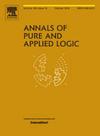On Recurrence Axioms
IF 0.6
2区 数学
Q2 LOGIC
引用次数: 0
Abstract
The Recurrence Axiom for a class of posets and a set A of parameters is an axiom scheme in the language of ZFC asserting that if a statement with parameters from A is forced by a poset in , then there is a ground containing the parameters and satisfying the statement.
The tightly super---Laver generic hyperhuge continuum implies the Recurrence Axiom for and . The consistency strength of this assumption can be decided thanks to our main theorems asserting that the minimal ground (bedrock) exists under a tightly -generic hyperhuge cardinal κ, and that κ in the bedrock is genuinely hyperhuge, or even super hyperhuge if κ is a tightly super---Laver generic hyperhuge definable cardinal.
The Laver Generic Maximum (LGM), one of the strongest combinations of axioms in our context, integrates practically all known set-theoretic principles and axioms in itself, either as its consequences or as theorems holding in (many) grounds of the universe. For instance, double plus version of Martin's Maximum is a consequence of LGM while Cichoń's Maximum is a phenomenon in many grounds of the universe under LGM.
关于递归公理
一类偏序集P和参数集a的递归公理是ZFC语言中的一个公理格式,它断言如果一个参数来自a的命题被P中的偏序集强制,则存在一个包含参数并满足该命题的根据。紧超- c(∞)-P-Laver型超巨型连续体蕴涵了P和H(2 ~ 0)的递推公理。这一假设的一致性可以通过我们的主要定理来确定,这些定理断言最小基底(基岩)存在于一个紧密的p -泛型超大基数κ下,并且基岩中的κ是真正的超大,甚至是超级C(∞)超大,如果κ是一个紧密的超级C(∞)-P-Laver泛型超大可定义基数。Laver泛极大值(LGM)是我们的背景中最强大的公理组合之一,它实际上整合了所有已知的集合论原理和公理,无论是作为它的结果还是作为在宇宙(许多)基础上成立的定理。例如,Martin极大值的双正版本是LGM的结果,而cichoski极大值是在LGM下宇宙的许多地方都存在的现象。
本文章由计算机程序翻译,如有差异,请以英文原文为准。
求助全文
约1分钟内获得全文
求助全文
来源期刊
CiteScore
1.40
自引率
12.50%
发文量
78
审稿时长
200 days
期刊介绍:
The journal Annals of Pure and Applied Logic publishes high quality papers in all areas of mathematical logic as well as applications of logic in mathematics, in theoretical computer science and in other related disciplines. All submissions to the journal should be mathematically correct, well written (preferably in English)and contain relevant new results that are of significant interest to a substantial number of logicians. The journal also considers submissions that are somewhat too long to be published by other journals while being too short to form a separate memoir provided that they are of particular outstanding quality and broad interest. In addition, Annals of Pure and Applied Logic occasionally publishes special issues of selected papers from well-chosen conferences in pure and applied logic.

 求助内容:
求助内容: 应助结果提醒方式:
应助结果提醒方式:


